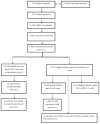The Kenya AIDS Indicator Survey 2012: rationale, methods, description of participants, and response rates
- PMID: 24732819
- PMCID: PMC4786178
- DOI: 10.1097/QAI.0000000000000114
The Kenya AIDS Indicator Survey 2012: rationale, methods, description of participants, and response rates
Abstract
Background: Cross-sectional population-based surveys are essential surveillance tools for tracking changes in HIV epidemics. In 2007, Kenya implemented the first AIDS Indicator Survey [Kenya AIDS Indicator Survey (KAIS) 2007)], a nationally representative, population-based survey that collected demographic and behavioral data and blood specimens from individuals aged 15-64 years. Kenya's second AIDS Indicator Survey (KAIS 2012) was conducted to monitor changes in the epidemic, evaluate HIV prevention, care, and treatment initiatives, and plan for an efficient and effective response to the HIV epidemic.
Methods: KAIS 2012 was a cross-sectional 2-stage cluster sampling design, household-based HIV serologic survey that collected information on households as well as demographic and behavioral data from Kenyans aged 18 months to 64 years. Participants also provided blood samples for HIV serology and other related tests at the National HIV Reference Laboratory.
Results: Among 9300 households sampled, 9189 (98.8%) were eligible for the survey. Of the eligible households, 8035 (87.4%) completed household-level questionnaires. Of 16,383 eligible individuals aged 15-64 years and emancipated minors aged less than 15 years in these households, 13,720 (83.7%) completed interviews; 11,626 (84.7%) of the interviewees provided a blood specimen. Of 6302 eligible children aged 18 months to 14 years, 4340 (68.9%) provided a blood specimen. Of the 2094 eligible children aged 10-14 years, 1661 (79.3%) completed interviews.
Conclusions: KAIS 2012 provided representative data to inform a strategic response to the HIV epidemic in the country.
Figures
References
-
- National AIDS Control Council (NACC) The Kenya AIDS Epidemic Update, 2011. NACC; Nairobi, Kenya: 2012. Available at: http://www.unaids.org/en/dataanalysis/knowyourresponse/countryprogressre.... Accessed May 20, 2013.
-
- oint United Nations Programme on HIV/AIDS (UNAIDS) Global AIDS Report 2012. UNAIDS; Geneva, Switzerland: 2012. Available at: http://www.unaids.org/en/dataanalysis/datatools/aidsinfo. Accessed June 19, 2013.
-
- National AIDS and STI Control Programme (NASCOP) 2007 Kenya AIDS Indicator Survey Final Report. NASCOP; Nairobi, Kenya: 2009. Available at: http://nascop.or.ke. Accessed May 20, 2013.
MeSH terms
Grants and funding
LinkOut - more resources
Full Text Sources
Other Literature Sources
Medical


